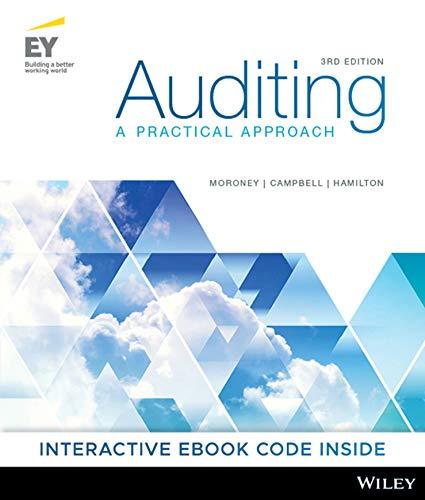MaxSecurity Limited (MaxSecurity) has been an audit client of Smith & Associates (S&A) for the past 15
Question:
MaxSecurity Limited (MaxSecurity) has been an audit client of Smith & Associates (S&A) for the past 15 years. MaxSecurity is based in Wollongong, where it manufactures high-tech armour-plated personnel carriers. MaxSecurity often has to go through a competitive market tender process to win large government contracts. Its main product, the small but powerful Terrain Master, is highly specialised and MaxSecurity only does business with nations that have a recognised, democratically elected government.
MaxSecurity maintains a highly secure environment, given the sensitive and confidential nature of its vehicle designs and its clients.
In September 2016, MaxSecurity installed an off-the-shelf costing system to support the highly sophisticated and cost sensitive nature of its product designs. The new system replaced a system that had been developed in-house as the old system could no longer keep up with the complex and detailed manufacturing costing process that provides tender costings. The old system also had difficulty with the company’s broader reporting requirements.
MaxSecurity’s IT department, together with the consultants from the software company, implemented the new manufacturing costing system. There were no customised modifications. Key operational staff and the internal audit team from MaxSecurity were significantly engaged in the selection, testing, training and implementation stages.
The manufacturing costing system uses all of the manufacturing unit inputs to calculate and produce a database of all product costs and recommended sales prices. It also integrates with the general ledger each time there are product inventories movements such as purchases, sales, wastage and damaged stock losses.
It is now February 2017 and you are commencing the audit planning for the 30 June 2017 annual financial report audit. You are assigned to assess MaxSecurity’s IT controls with particular emphasis on the recent implementation of the new manufacturing costing system.
Source: Adapted from the CA Program’s Audit & assurance exam, May 2008.
Required Select two (2) components of internal control. Explain how the role of internal and external audit would differ in assessing these components in relation to the new manufacturing costing system.
Questions 6.36 and 6.37 are based on the following case.
Chan & Partners Chartered Accountants is a successful mid-tier accounting firm with a large range of clients across Australia. During the 2017 year, Chan & Partners gained a new client, Medical Services Holdings Group (MSHG), which owns 100 per cent of the following entities:
• Shady Oaks Hospital, a private hospital group • Gardens Nursing Home Pty Ltd, a private nursing home • Total Cancer Specialists Limited (TCSL), a private oncology clinic that specialises in the treatment of cancer.
Year-end for all MSHG entities is 30 June.
During the 2017 financial year, MSHG released its own range of medical supplies such as bandages and first aid kits, which are sold via direct marketing by a sales team employed by the hospital.
The sales team are remunerated via a base salary and a bonus component which is based upon the dollar value of sales they generate. You recognise that their main motivation is to maximise their bonuses.
On 1 April 2017, Gardens Nursing Home Pty Ltd switched from its ‘home grown’ patient revenue system to MSHG’s equivalent system. MSHG is confident that its ‘off the shelf’ enterprise system would perform all of the functions that Gardens Nursing Home’s home grown system performed.
Gardens Nursing Home’s home grown patient revenue system comprised the following.
1. Billing system — produces the invoice to charge the patient for services provided such as accommodation, medications and medical services. This software includes a complex formula to calculate the patient bill allowing for government subsidies, pensioner benefits and private medical insurance company benefits plans.
2. Patient database — a master file containing personal details about the patient as well as the period of stay, services provided and patient’s medical insurance details.
3. Rates database — a master file that shows all accommodation billing rates, rebate discounts and government assistance benefits.
At the request of the board, the group’s internal audit unit was involved throughout the entire switchover process. The objective of its engagement, as the board stated, was to ‘make sure the switch-over worked without any problems’.
Step by Step Answer:

Auditing A Practical Approach
ISBN: 9780730364573
3rd Edition
Authors: Robyn Moroney, Fiona Campbell, Jane Hamilton





